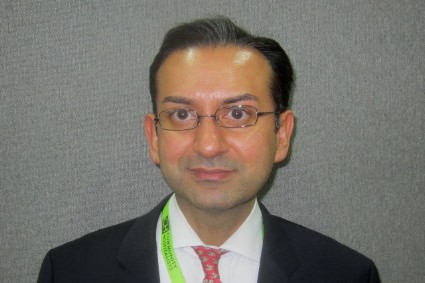User login
LAS VEGAS – About 40% of atrial fibrillation inpatients leave the hospital without a prescription for stroke prevention medications, according to a retrospective review from Northwestern University in Chicago.
Investigators there calculated the CHADS2(congestive heart failure, hypertension, age, diabetes, prior stroke) score of 16,106 patients discharged with atrial fibrillation diagnosed by 12-lead EKG or telemetry. Guidelines call for aspirin or anticoagulation in patients with a score of 1, and anticoagulation in patients with scores of 2-6, according to lead researcher Dr. Hiren Shah, medical director of the medicine and cardiac telemetry hospitalist unit at Northwestern Memorial Hospital in Chicago.
Even so, 41.2% of 277 patients with a CHADS2 score of 6 and 36% of of patients with a score of 5 were discharged without a prescription to prevent stroke. Additionally, 36.8% of 1,550 with a score of 4 left the hospital without such a prescription, as did 35.9% of 3,343 patients with a score of 3, 38.8% of 4,106 of patients with a score of 2 and 40.3% of 3,457 patients with a score of 1.
Among patients who were treated, about 15% with a score of 2-6 received aspirin alone, instead of warfarin or newer anticoagulants. When anticoagulation was initiated, warfarin was the most common choice.
"These data, I think, would mirror the overall population of patients throughout the country. There’s a major quality gap in atrial fibrillation. I would urge hospitalists to start quality improvement projects to address this very important clinical issue," Dr. Shah said.
The reasons for the findings are uncertain. It’s unknown if patients were started on stroke prophylaxis after discharge. The study, comprising two years of patient data starting Nov.1, 2011, also did not assess outcomes or reasons why patients went untreated.
It could be that hospitalists didn’t have time to discuss anticoagulation with patients, or didn’t calculate CHADS2 scores. They might also have overestimated bleeding risks, although if "you’re at CHADS 5 or 6, your stroke risk is 12% and 18% per year, so unless the contraindication to anticoagulation is absolute, the risk of bleeding would have to be very high for you not to choose anticoagulation," Dr. Shah said at the Society of Hospital Medicine annual meeting.
Hospitalists might also have thought that anticoagulation is an outpatient issue, "but we think the hospital is a nice point in time where you can capture these patients and evaluate them for this issue, then communicate their stroke risk to their primary care doctor," he said.
One of the solutions is a reminder in the electronic health record to do a CHADS score, so long as the system can recognize atrial fibrillation patients. Also, with the help of funding from the Society of Hospital Medicine, "we are going to have a mentored implementation program where we’ll go to hospitals and coach them on how to improve, similar to what we did for DVT/PE [deep vein thrombosis/pulmonary embolism] prophylaxis," Dr. Shah said.
Atrial fibrillation, in general, "is at the point where DVT/PE was several years ago. Prophylaxis was sporadic, and then there was a big push. We think atrial fibrillation is a similar condition that will be addressed aggressively in time by all hospitals," he said.
Dr. Shah is a speaker for Janssen Pharmaceuticals, the maker of the anticoagulant rivaroxaban (Xarelto). He is also an editorial adviser for Hospitalist News. He said his work received no outside funding.
LAS VEGAS – About 40% of atrial fibrillation inpatients leave the hospital without a prescription for stroke prevention medications, according to a retrospective review from Northwestern University in Chicago.
Investigators there calculated the CHADS2(congestive heart failure, hypertension, age, diabetes, prior stroke) score of 16,106 patients discharged with atrial fibrillation diagnosed by 12-lead EKG or telemetry. Guidelines call for aspirin or anticoagulation in patients with a score of 1, and anticoagulation in patients with scores of 2-6, according to lead researcher Dr. Hiren Shah, medical director of the medicine and cardiac telemetry hospitalist unit at Northwestern Memorial Hospital in Chicago.
Even so, 41.2% of 277 patients with a CHADS2 score of 6 and 36% of of patients with a score of 5 were discharged without a prescription to prevent stroke. Additionally, 36.8% of 1,550 with a score of 4 left the hospital without such a prescription, as did 35.9% of 3,343 patients with a score of 3, 38.8% of 4,106 of patients with a score of 2 and 40.3% of 3,457 patients with a score of 1.
Among patients who were treated, about 15% with a score of 2-6 received aspirin alone, instead of warfarin or newer anticoagulants. When anticoagulation was initiated, warfarin was the most common choice.
"These data, I think, would mirror the overall population of patients throughout the country. There’s a major quality gap in atrial fibrillation. I would urge hospitalists to start quality improvement projects to address this very important clinical issue," Dr. Shah said.
The reasons for the findings are uncertain. It’s unknown if patients were started on stroke prophylaxis after discharge. The study, comprising two years of patient data starting Nov.1, 2011, also did not assess outcomes or reasons why patients went untreated.
It could be that hospitalists didn’t have time to discuss anticoagulation with patients, or didn’t calculate CHADS2 scores. They might also have overestimated bleeding risks, although if "you’re at CHADS 5 or 6, your stroke risk is 12% and 18% per year, so unless the contraindication to anticoagulation is absolute, the risk of bleeding would have to be very high for you not to choose anticoagulation," Dr. Shah said at the Society of Hospital Medicine annual meeting.
Hospitalists might also have thought that anticoagulation is an outpatient issue, "but we think the hospital is a nice point in time where you can capture these patients and evaluate them for this issue, then communicate their stroke risk to their primary care doctor," he said.
One of the solutions is a reminder in the electronic health record to do a CHADS score, so long as the system can recognize atrial fibrillation patients. Also, with the help of funding from the Society of Hospital Medicine, "we are going to have a mentored implementation program where we’ll go to hospitals and coach them on how to improve, similar to what we did for DVT/PE [deep vein thrombosis/pulmonary embolism] prophylaxis," Dr. Shah said.
Atrial fibrillation, in general, "is at the point where DVT/PE was several years ago. Prophylaxis was sporadic, and then there was a big push. We think atrial fibrillation is a similar condition that will be addressed aggressively in time by all hospitals," he said.
Dr. Shah is a speaker for Janssen Pharmaceuticals, the maker of the anticoagulant rivaroxaban (Xarelto). He is also an editorial adviser for Hospitalist News. He said his work received no outside funding.
LAS VEGAS – About 40% of atrial fibrillation inpatients leave the hospital without a prescription for stroke prevention medications, according to a retrospective review from Northwestern University in Chicago.
Investigators there calculated the CHADS2(congestive heart failure, hypertension, age, diabetes, prior stroke) score of 16,106 patients discharged with atrial fibrillation diagnosed by 12-lead EKG or telemetry. Guidelines call for aspirin or anticoagulation in patients with a score of 1, and anticoagulation in patients with scores of 2-6, according to lead researcher Dr. Hiren Shah, medical director of the medicine and cardiac telemetry hospitalist unit at Northwestern Memorial Hospital in Chicago.
Even so, 41.2% of 277 patients with a CHADS2 score of 6 and 36% of of patients with a score of 5 were discharged without a prescription to prevent stroke. Additionally, 36.8% of 1,550 with a score of 4 left the hospital without such a prescription, as did 35.9% of 3,343 patients with a score of 3, 38.8% of 4,106 of patients with a score of 2 and 40.3% of 3,457 patients with a score of 1.
Among patients who were treated, about 15% with a score of 2-6 received aspirin alone, instead of warfarin or newer anticoagulants. When anticoagulation was initiated, warfarin was the most common choice.
"These data, I think, would mirror the overall population of patients throughout the country. There’s a major quality gap in atrial fibrillation. I would urge hospitalists to start quality improvement projects to address this very important clinical issue," Dr. Shah said.
The reasons for the findings are uncertain. It’s unknown if patients were started on stroke prophylaxis after discharge. The study, comprising two years of patient data starting Nov.1, 2011, also did not assess outcomes or reasons why patients went untreated.
It could be that hospitalists didn’t have time to discuss anticoagulation with patients, or didn’t calculate CHADS2 scores. They might also have overestimated bleeding risks, although if "you’re at CHADS 5 or 6, your stroke risk is 12% and 18% per year, so unless the contraindication to anticoagulation is absolute, the risk of bleeding would have to be very high for you not to choose anticoagulation," Dr. Shah said at the Society of Hospital Medicine annual meeting.
Hospitalists might also have thought that anticoagulation is an outpatient issue, "but we think the hospital is a nice point in time where you can capture these patients and evaluate them for this issue, then communicate their stroke risk to their primary care doctor," he said.
One of the solutions is a reminder in the electronic health record to do a CHADS score, so long as the system can recognize atrial fibrillation patients. Also, with the help of funding from the Society of Hospital Medicine, "we are going to have a mentored implementation program where we’ll go to hospitals and coach them on how to improve, similar to what we did for DVT/PE [deep vein thrombosis/pulmonary embolism] prophylaxis," Dr. Shah said.
Atrial fibrillation, in general, "is at the point where DVT/PE was several years ago. Prophylaxis was sporadic, and then there was a big push. We think atrial fibrillation is a similar condition that will be addressed aggressively in time by all hospitals," he said.
Dr. Shah is a speaker for Janssen Pharmaceuticals, the maker of the anticoagulant rivaroxaban (Xarelto). He is also an editorial adviser for Hospitalist News. He said his work received no outside funding.
AT HOSPITAL MEDICINE 2014
Major finding: A total of 36% of patients with a CHADS2 score of 5, and 41.2% with a score of 6 left the hospital without medications to prevent stroke.
Data Source: Retrospective review of more than 2 years of data for 16,000 patients hospitalized for atrial fibrillation patients
Disclosures: The lead investigator is a speaker for Janssen Pharmaceuticals, maker of rivaroxaban). He said his work received no outside funding.

